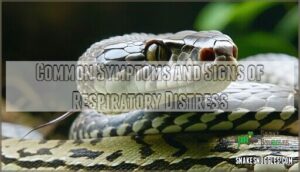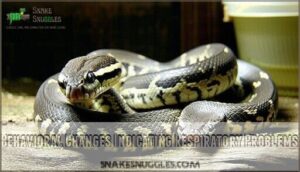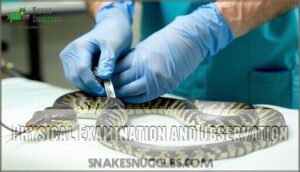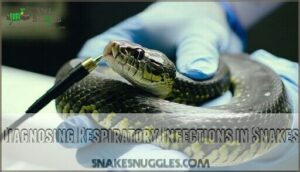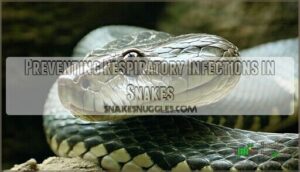This site is supported by our readers. We may earn a commission, at no cost to you, if you purchase through links.
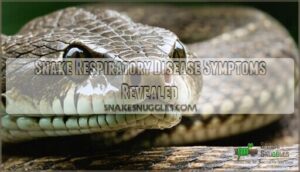
Listen for wheezing, clicking sounds, or labored breathing. Watch for mouth breathing, bubbles around the nose or mouth, and discharge from nostrils.
Your snake might rest with its head elevated or in a stretched position – think of it like propping up pillows when you’re congested. Look for pale or blue-tinged gums, excessive yawning, and faster breathing rates.
These respiratory issues can escalate quickly, so early detection makes all the difference. Understanding the underlying causes and proper treatment approaches can help you respond effectively when these symptoms appear.
Table Of Contents
- Key Takeaways
- Identifying Respiratory Issues in Snakes
- Causes and Risk Factors of Respiratory Infections
- Diagnosing Respiratory Infections in Snakes
- Treatment and Management of Respiratory Infections
- Preventing Respiratory Infections in Snakes
- Frequently Asked Questions (FAQs)
- How to tell if your snake has a respiratory infection?
- What causes respiratory disease in snakes?
- Will snake respiratory infection go away on its own?
- How do you fix respiratory problems in snakes?
- What are the symptoms of the snake virus?
- How long does a snake respiratory infection usually last?
- Can respiratory infections in snakes be contagious to humans?
- Do respiratory infections affect certain snake species more?
- What role does humidity play in snake respiratory health?
- Can a snake recover from a respiratory infection completely?
- Conclusion
Key Takeaways
- You’ll want to recognize snake respiratory disease symptoms like wheezing, labored breathing, and pale gums, so you can take action quickly and get your snake the help it needs.
- It’s crucial to understand that poor husbandry practices, stress, and age can increase the risk of respiratory infections in snakes, and you can prevent most infections by maintaining proper husbandry conditions.
- You should work closely with your veterinarian to create a treatment plan that combines medications with supportive care, such as fluid therapy, heat support, and oxygen therapy, to help your snake recover from a respiratory infection.
- By taking preventive measures, like keeping humidity between 40-60%, providing a clean environment, and scheduling regular veterinary check-ups, you can help your snake thrive and avoid the dangers of respiratory infections.
Identifying Respiratory Issues in Snakes
You’ll need to recognize the signs of respiratory issues in your snake, such as wheezing, nasal discharge, or labored breathing.
By understanding these symptoms, you can identify potential respiratory problems early on and take action to guarantee your snake receives the proper care it needs, which is crucial for addressing respiratory issues.
Common Symptoms and Signs of Respiratory Distress
You’ll notice snake respiratory disease symptoms like wheezing sounds, nasal discharge, and open-mouth breathing.
Watch for wheezing, nasal discharge, and open-mouth breathing—these are early warning signs your snake needs help!
Labored breathing, loss of appetite, and lethargy are also signs.
Recognize these symptoms to address snake breathing problems and respiratory issues promptly, ensuring your pet’s health and well-being.
Differences in Symptoms Between Species
Not all snake species show the same respiratory symptoms. While general signs like wheezing and nasal discharge appear across species, you’ll notice distinct patterns based on what type of snake you’re dealing with.
Python symptoms tend to be more pronounced, with these snakes showing obvious respiratory distress. Boas, particularly larger species, often display subtler signs like lethargy and temperature preference changes. Meanwhile, colubrids rarely show respiratory issues at all.
Here’s what to watch for in different snake groups:
- Boid vs. Colubrid: Boids (pythons and boas) commonly develop respiratory infections with clear symptoms, while colubrids show minimal signs even when infected.
- Viper Specifics: Vipers frequently suffer from paramyxovirus infections, leading to secondary bacterial respiratory problems and neurological symptoms like tremors.
- Geographic Variations: Tropical species face higher fungal infection risks, while desert snakes battle dehydration-related respiratory stress.
- Captive vs. Wild: Captive snakes show clearer respiratory disease symptoms due to controlled observation environments. Larger snakes are particularly susceptible, with boas and pythons often affected.
Behavioral Changes Indicating Respiratory Problems
Your snake’s behavior speaks volumes about its health.
Lethargy signs like reduced movement and appetite changes signal trouble.
Watch for unusual yawning, restlessness cues, and breathing posture shifts.
Snake openmouth breathing and snake wheezing scream emergency.
Snake lethargy paired with snake loss appetite often indicates snake respiratory disease.
These behavioral red flags appear before physical symptoms worsen.
Behavioral Changes What it Might Mean
Get your snake to a vet ASAP if you notice any of these changes!
Physical Examination and Observation
After spotting behavioral changes, it’s time for a hands-on check-up. Look closely for irregular breathing sounds. Check for nasal discharge. A mouth examination can reveal inflammation. Look at gum color. Note the body posture. These are key snake respiratory signs.
Bacterial agents are common causes. Don’t forget to check the skin condition.
- Is there unusual swelling?
- Are they holding their head up?
- Is the snake lethargic?
- Are they restless?
Causes and Risk Factors of Respiratory Infections
You’re likely wondering what causes respiratory infections in snakes, and to comprehend this, poor husbandry practices, bacterial, viral, or fungal pathogens can increase the risk.
As you learn more about the causes and risk factors, you’ll find that stress, age, health, and nutrition also play a significant role in respiratory infections in snakes.
Poor Husbandry Practices and Overcrowding
You can prevent snake respiratory infection by ensuring proper enclosure sanitation, temperature gradients, and humidity control.
This helps reduce stress and poor husbandry practices that lead to disease spread.
Making quarantine protocols essential for snake housing ventilation.
Bacterial, Viral, Fungal, and Parasitic Infections
You’ll encounter bacterial, viral, fungal, and parasitic infections, which can cause snake respiratory infection.
Bacterial pathogens, viral transmission, and fungal infections are common, while parasite control is key to preventing coinfections, including bacterial, fungal, viral, and parasitic infections that can harm your snake.
Reptiles in suboptimal living conditions are highly susceptible to these infections.
Weakened Immune System and Stress
Under stress, your snake’s immune system weakens dramatically, leaving it vulnerable to respiratory infections.
A stressed snake’s defenses crumble fast—leaving it wide open to serious respiratory infections and illness.
Stress Impact creates a domino effect that compromises your pet’s natural defenses against pathogens.
Common Environmental Stressors include:
- Poor husbandry practices and inadequate hiding spots
- Excessive handling causing Handling Stress
- Nutritional Deficiencies from improper diet
Creating a stressfree environment helps maintain strong immune system function and prevents weakness signs.
Age, Health, and Nutrition as Risk Factors
As you care for your snake, remember its age, health, and nutrition impact its immune system.
A weakened immune system, due to juvenile vulnerability or geriatric immunity, increases the risk of snake respiratory infection.
Making proper snake husbandry, nutrition, and hydration essential to prevent malnutrition effects and supplementation risks.
Diagnosing Respiratory Infections in Snakes
You’re now going to learn how to diagnose respiratory infections in snakes, which is essential for their health and well-being.
By using techniques like radiographs and blood work, you can identify the symptoms and causes of respiratory infections in your snake.
Radiographs and Imaging Techniques
You’ll use diagnostic techniques like X-rays, CT scans, and imaging to visualize your snake’s lungs.
Here are three methods:
- X-rays for fluid or masses
- CT scans for detailed views
- Ultrasound for airway exams, aiding in snake respiratory disease diagnosis with radiograph interpretation.
Blood Work and Fecal Sample Evaluation
When diagnosing snake respiratory disease, your vet will run blood tests to check for Blood Parasites, Bacterial Presence, and Fungal Identification.
While fecal samples help identify Nutritional Deficiencies affecting your snake’s Immune Response.
Guiding veterinary diagnostics and treatment for snake diseases.
Respiratory Pathogen Testing and PCR
Once you’ve gone through blood work and fecal samples, PCR testing steps in to pinpoint what’s causing your snake’s respiratory infection.
PCR accuracy is usually high for detecting specific respiratory pathogens, including emerging viruses and tricky bacteria. Still, sample collection matters—a poor swab or missing the right time for sampling can throw off results or lead to false negatives.
Test interpretation helps you know if it’s a viral infection, a fungal culprit, or even something new. Costs for these tests can hit $50 to $200 per sample, depending on the lab.
It’s a small price for peace of mind when you’re tracking down snake viruses. To prevent issues, consider suitable husbandry practices.
- Quick swabbing is non-invasive
- Results guide treatment
- Finds rare or new pathogens
Sedation and Advanced Diagnostic Procedures
When initial testing doesn’t reveal the culprit, your vet might recommend advanced diagnostic procedures that require sedation. These techniques give veterinarians a clearer picture of what’s happening inside your snake’s respiratory system.
Sedation Protocols guarantee your snake stays calm during complex procedures like endoscopic biopsy and CT scans. Pulmonoscopy lets vets examine lung tissue directly, while lavage techniques flush the airways to collect samples for analysis.
| Procedure | Sedation Level | Recovery Time |
|---|---|---|
| Endoscopy | Light to Moderate | 1-2 hours |
| CT Scans | Moderate | 2-3 hours |
| Pulmonoscopy | Deep | 3-4 hours |
| Lavage Techniques | Moderate to Deep | 2-4 hours |
These diagnostic techniques help pinpoint specific pathogens causing snake respiratory infections. Your vet weighs risks carefully before recommending sedation. Advanced endoscopy provides detailed views of lung function, making accurate snake diagnosis possible when standard methods fall short.
Treatment and Management of Respiratory Infections
Once you’ve confirmed your snake has a respiratory infection, quick treatment becomes essential for recovery.
You’ll need to work closely with your veterinarian to create a treatment plan that combines medications with supportive care to help your snake breathe easier.
Antibiotics, Anti-Parasitic, and Anti-Fungal Medications
Treatment success hinges on selecting the right medication for your snake’s specific infection.
Your veterinarian will prescribe targeted therapies based on diagnostic results, ensuring effective treatment while minimizing risks.
- Enrofloxacin and ceftazidime target bacterial infections with proven effectiveness
- Itraconazole combats fungal infections like Aspergillus and snake fungal disease
- Ivermectin eliminates parasitic causes including lungworms and roundworms
- Nebulization therapy delivers medications directly to respiratory tissues
- Probiotic use counteracts antibiotic side-effects and supports gut health
- Drug interactions require careful monitoring when combining multiple treatments
Always follow prescribed dosages exactly.
Medication side-effects like lethargy or appetite loss need immediate veterinary attention.
Antibiotic resistance develops when treatments aren’t completed properly, making future infections harder to treat.
Supportive Care and Fluid Therapy
When your snake battles respiratory distress, supportive care becomes your lifeline.
Fluid therapy combats dehydration through IV or subcutaneous fluids, restoring essential electrolyte balance. Your vet handles medication delivery while you monitor hydration techniques at home.
Offer shallow water dishes for easy access. Recovery monitoring includes watching for improved appetite stimulation and reduced breathing difficulty during snake respiratory infection treatment.
Probiotic paste can also be beneficial as it supports gut health and overall immune function.
Heat Support, Oxygen Therapy, and Environmental Adjustments
Creating the perfect healing environment for your snake respiratory infection involves three essential elements working together like a well-tuned orchestra.
Optimal Temperatures between 80-85°F boost your snake’s metabolism and immune response. Humidity Control at 40-60% prevents further irritation while Ventilation Strategies ensure fresh airflow. Nebulization Therapy delivers medication directly to affected areas.
Maintaining proper temperature is vital, and a quality heat source can greatly assist in this.
- Temperature regulation – Your snake’s immune system depends on proper heat
- Humidity balance – Too dry worsens symptoms, too wet breeds bacteria
- Fresh air circulation – Stagnant air traps pathogens and slows recovery
- Oxygen therapy – Critical support when breathing becomes labored
Dietary Changes and Nutritional Support
Good nutrition fuels your snake’s recovery from respiratory disease.
Vitamin A helps rebuild damaged respiratory tissues, while balanced nutrition supports immune function.
Consider vitamin supplementation if your vet recommends it.
Hydration importance can’t be overstated – dehydrated snakes heal slower.
Appetite stimulation through gentle warming may help, but don’t force-feed.
Address nutritional deficiencies with dietary enhancers to boost nutrient intake during recovery.
Some owners specifically seek Vitamin A products for their snakes.
Preventing Respiratory Infections in Snakes
You can prevent most respiratory infections in snakes by maintaining proper husbandry conditions and staying vigilant about your pet’s health.
Creating the right environment with correct temperature, humidity, and cleanliness will keep your snake’s immune system strong and reduce the risk of dangerous respiratory diseases.
Proper Husbandry and Hygiene Practices
Since proper husbandry prevents most respiratory infections, you’ll want to establish consistent routines that protect your snake’s health.
Think of these practices as building a fortress against disease:
- Enclosure Cleaning: Weekly substrate changes and monthly deep cleaning prevent bacterial buildup
- Humidity Control: Maintain 40-60% humidity using reliable gauges and proper ventilation
- Temperature Gradients: Provide 80-85°F basking spots with 75-80°F cool zones for ideal immune function
- Ventilation Quality: Guarantee fresh air circulation without drafts through proper screen placement
- Quarantine Protocols: Isolate new snakes for 30 days before introducing them to your collection
To bolster their immune system, offer varied prey types.
Regular Veterinary Care and Check-Ups
Preventative medicine beats crisis management every time.
Schedule annual vet visits for early detection of snake respiratory infection issues before they become serious problems.
Your snake vet will perform parasite screening, offer husbandry advice, and provide proactive healthcare guidance.
Regular veterinary care helps you stay ahead of potential health issues through professional monitoring and expert recommendations.
Quarantine and Isolation Procedures
When dealing with new reptiles, you’ll want to quarantine them for at least 30 days before introducing them to your collection.
Set up a separate quarantine environment with proper temperature, humidity, and hiding spots.
If disease strikes, isolate sick snakes immediately and disinfect all surfaces using appropriate biosecurity measures. Monitor symptoms daily during quarantine duration and follow strict handling protocols to prevent cross-contamination between animals.
Nutrition and Supplements for Immune System Support
In terms of keeping your snake’s immune system strong, a little goes a long way.
Try:
- Adding Probiotic Use for healthy guts
- Giving Vitamin A Benefits a boost with veggies or supplements
- Focusing on Hydration Importance with fresh water daily
- Offering Balanced Diet and careful Supplement Dosage
Ask your vet about nutrient supplementation and immune boosters before starting vitamins. Consider snake gut health for immune support.
Frequently Asked Questions (FAQs)
How to tell if your snake has a respiratory infection?
Look for wheezing sounds, nasal discharge, open-mouth breathing, and labored breathing patterns. Watch for lethargy, loss of appetite, and your snake holding its head elevated while resting.
What causes respiratory disease in snakes?
Poor husbandry strikes like a silent predator, weakening your snake’s defenses.
Dirty enclosures, improper temperatures, humidity fluctuations, stress, and poor ventilation create perfect conditions for bacterial, viral, or fungal respiratory infections, which can be exacerbated by poor ventilation.
Will snake respiratory infection go away on its own?
No, snake respiratory infections won’t resolve on their own.
You’ll need veterinary treatment with antibiotics, proper environmental conditions, and supportive care.
Delaying treatment can lead to serious complications or death in your snake.
How do you fix respiratory problems in snakes?
Don’t let this be a uphill battle! You’ll need antibiotics from a vet, improve temperature/humidity levels, enhance ventilation, and provide supportive care like nebulization therapy.
What are the symptoms of the snake virus?
Viral infections in snakes cause labored breathing, open-mouth breathing, excess mucus, lethargy, appetite loss, poor coordination, "star-gazing" behavior, trouble shedding, and decreased activity levels.
How long does a snake respiratory infection usually last?
You’ll typically see a snake’s respiratory infection last several weeks to months, depending on the severity and treatment, so it’s imperative to seek veterinary care promptly.
Can respiratory infections in snakes be contagious to humans?
You’re unlikely to catch respiratory infections from snakes, but poor hygiene can spread bacteria, so wash your hands thoroughly after handling them or their enclosures.
Do respiratory infections affect certain snake species more?
When the chips are down, you’ll find larger, sedentary snakes, like Boids, are more prone to respiratory issues than others, due to their size and less active lifestyle.
What role does humidity play in snake respiratory health?
You should keep humidity between 40-60% to prevent respiratory issues in snakes, as low or high humidity can trigger infections and worsen breathing difficulties.
Can a snake recover from a respiratory infection completely?
You can help a snake recover from a respiratory infection with proper care, including antibiotics, a clean environment, and veterinary guidance, which can lead to a complete recovery.
Conclusion
Now you’re equipped to spot snake respiratory disease symptoms, from wheezing to pale gums.
You’ll take action quickly, knowing early detection is key.
By understanding these signs and taking preventive measures, you’ll help your snake thrive, avoiding the dangers of respiratory infections, and recognizing snake respiratory disease symptoms is the first step to preventing the dangers of respiratory infections.
- https://wpvet.com/reptile-rounds/respiratory-infections/
- https://www.petmd.com/reptile/conditions/respiratory/respiratory-infections-reptiles
- https://www.merckvetmanual.com/all-other-pets/reptiles/disorders-and-diseases-of-reptiles
- https://pubmed.ncbi.nlm.nih.gov/33892890/
- https://azeah.com/reptiles-amphibians/respiratory-infections-reptiles

